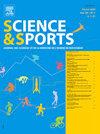Bronchoconstriction induite par l’exercice chez les enfants non asthmatiques : étude de cohorte observationnelle
IF 0.8
4区 医学
Q4 SPORT SCIENCES
引用次数: 0
Abstract
Objectif
L’objectif de cette étude est de déterminer la prévalence de la bronchoconstriction induite par l’exercice (BIE) chez une population d’écoliers non asthmatiques ainsi que la prévalence des symptômes respiratoires associés au BIE.
Méthodes
Cette étude de cohorte, observationnelle et transversale, a inclus 213 écoliers, non asthmatiques, âgés de 15,2 ± 0,69 ans. Une spirométrie a été réalisée avant et immédiatement après un test d’effort sur le terrain (test de récupération intermittente : test Yo-Yo). Le diagnostic positif de la BIE a été posé si le volume expiratoire maximal de la première seconde (VEMS) diminuait de 10 % ou plus, par rapport à la valeur initiale, après l’exercice. Les symptômes respiratoires après le test d’effort ont été enregistrés.
Résultats
Après le test d’effort, 59,6 % des enfants souffraient de toux et 51,2 % souffraient de BIE. La prévalence de la dyspnée provoquée par l’effort était de 41,7 %. Les participants avec BIE avaient un VEMS post-exercice significativement inférieur à ceux ne présentant pas de BIE (p < 0,01). Parmi les participants présentant des symptômes respiratoires liés à l’exercice, 94,4 % souffraient de BIE. La toux et la dyspnée étaient indépendamment associées à la BIE (r = 0,55, p = 0,01).
Conclusion
Les résultats de notre étude montrent bien que la BIE est fréquente chez des enfants non asthmatiques. La toux et la dyspnée étaient les symptômes respiratoires associées à la BIE, suggérant que leur présence pourrait être un bon marqueur du diagnostic de BIE.
Objective
We aimed to determine the prevalence of exercise-induced bronchoconstriction (EIB) in a population of non-asthmatic schoolchildren as well as the prevalence of symptoms associated with EIB.
Methods
This observational and cross-sectional cohort study included 213 schoolchildren, non-asthmatic, aged 15.2 ± 0.69 years. Spirometry was performed before and immediately after a field exercise test (intermittent recovery test: Yo-Yo test). The diagnosis of EIB was made if the 1st second forced expiratory volume (FEV1) decreased from baseline of 10% or more after exercise. Respiratory symptoms after exercise test were recorded.
Results
After exercise, 59.6% of children suffered from cough and 51.2% had EIB. The prevalence of exercise-induced dyspnea was 41.7%. Participants with EIB had significantly lower post-exercise FEV1 than those not presenting EIB (P < 0.01). Among participants with exercise related symptoms, 94.4% had EIB. Cough and dyspnea were independently associated with EIB (r = 0.55, P = 0.01).
Conclusion
The results of our study clearly show that EIB is common in non-asthmatic children. Cough and dyspnea were the respiratory symptoms associated with BIE, suggesting that their presence could be a good marker for the diagnosis of BIE.
非哮喘儿童运动引起的支气管炎:观察队列研究
目的:本研究的目的是确定非哮喘学童中运动引起的支气管收缩(BIE)的流行率,以及与BIE相关的呼吸症状的流行率。这项横断面观察队列研究包括213名年龄为15.2±0.69岁的无哮喘学童。如果运动后最大第一秒呼气量(EMS)比原值下降10%或更多,则确诊为BIE阳性。压力测试后出现呼吸症状。在压力测试后,59.6%的儿童出现咳嗽,51.2%出现BIE。运动引起的呼吸困难的患病率为41.7%。有IBE的参与者运动后EMS明显低于没有IBE的参与者(p <;0.01)。在出现与运动有关的呼吸症状的参与者中,94.4%患有BIE。咳嗽和呼吸困难与BIE独立相关(r = 0.55, p = 0.01)。结论我们的研究结果清楚地表明,BIE在非哮喘儿童中很常见。咳嗽和呼吸困难是与BIE相关的呼吸道症状,这表明它们的存在可能是BIE诊断的一个很好的标志。我们的目标是确定运动引起的支气管炎(EIB)在非哮喘学童人群中的流行率,以及与EIB相关的症状的流行率。这项观察性和横断面队列研究包括213名学龄儿童,无哮喘,年龄15.2±0.69岁。在现场运动测试(间歇性恢复测试:溜溜球测试)之前和之后立即进行气度测量。如果运动后第一秒强制呼气量(FEV1)从基线下降10%或以上,则诊断为EIB。记录运动测试后的呼吸症状。结果运动后,59.6%的儿童出现咳嗽,51.2%的儿童出现EIB。运动引起的睡眠呼吸暂停的患病率为41.7%。与非欧洲投资银行的参与者相比,持有欧洲投资银行的参与者在营业后的2月1日的利润明显较低(P <;0.01)。在有运动相关症状的参与者中,94.4%的人患有EIB。与EIB (r = 0.55, P = 0.01)独立相关的咳嗽和呼吸困难。结论我们的研究结果清楚地表明,EIB在非哮喘儿童中很常见。与BIE相关的呼吸症状包括咳嗽和呼吸困难,这表明它们的存在可能是诊断BIE的一个很好的标志。
本文章由计算机程序翻译,如有差异,请以英文原文为准。
求助全文
约1分钟内获得全文
求助全文
来源期刊

Science & Sports
社会科学-运动科学
CiteScore
1.50
自引率
18.20%
发文量
143
审稿时长
19.7 weeks
期刊介绍:
Science & Sports is a peer-reviewed journal, publishing worldwide high-quality and impactful papers of medical, scientific and applied technical research in the different fields of sports and physical activities: sport medicine, exercise physiology, sport physiology and performance, nutrition, traumatology relating to sport, rehabilitation or adapted physical activities. It facilitates the transfer of knowledge and technology between the clinic, research and practice in physical and athletic activity.
 求助内容:
求助内容: 应助结果提醒方式:
应助结果提醒方式:


